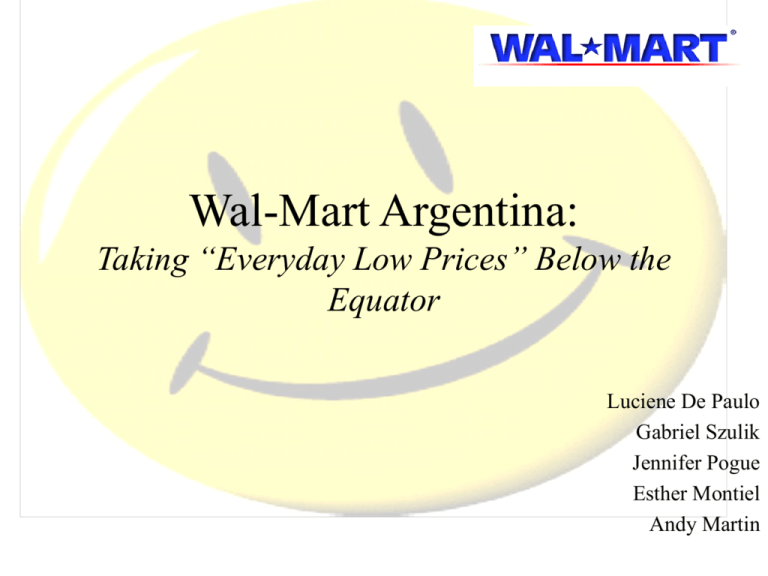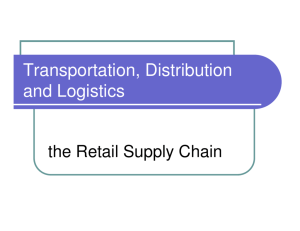Wal-Mart Argentina Entry Strategy Analysis & Case Study
advertisement

Wal-Mart Argentina: Taking “Everyday Low Prices” Below the Equator Luciene De Paulo Gabriel Szulik Jennifer Pogue Esther Montiel Andy Martin Agenda • Wal-Mart’s Background and International Expansion • Argentina: Analysis and Entry options • DCF and Cost of Capital Discussion • Recommendation • Q&A • Should Wal-Mart enter Argentina? If so, which entry strategy should it follow? Wal-Mart: A Successful Story • Last 20 years: – Average ROE of 33% – Average sales growth of 25% • Everyday Low Price Strategy • Advanced Technology • Low Margins and High Volume Wal-Mart International Strategic focus on international expansion • Stable economies: • Attractive markets: – Canada – Mexico – Argentina – Brazil – China – Exploring opportunities in Europe – Higher expected returns, yet highly volatile Argentina: the target • Economic Outlook • Retail Market • Methods of Entry Economic Outlook Positive • • • • Open economy Law of Convertibility Increasing consumption and GDP levels Inflation controlled Argentine GDP Argentine Inflation Argentine Market Openness Retail Market Attractive • Retail market underdeveloped – Only one hyper market chain (Carrefour) • Small businesses threatened by big players • Total retail size in 1993: US$ 67.9 billion – US$8.6 billion among supermarkets and hypermarkets • Low distribution and technological capabilities Market Considerations • • • • Families shop together People buy smaller items, more often Fewer car owners than U.S. Corrupt local business environment relationships with suppliers and politicians necessary Wal-Mart may need a local partner… Methods of Entry 1. Wal-Mart entering on its own, building stores from scratch 2. Acquisition of a local retailer 3. Joint Venture Disco S.A.: A Possible Partner • • • • • Largest retailer: 57 branches 4th retailer in sales revenue: US$805 MM in 1993 Outstanding geographic locations Highly competitive prices Strong financials, profitable local established retailer • Smaller stores than a typical Wal-Mart Supercenter Evaluation of risks • Political – – – – Import controls Democracy level Corruption Taxes • Economic – Exchange rate – Inflation Evaluation of risks (cont.) • Financial – Interest rates – Banking system • Industry risks – Consumer default risk Specific risks of the project • Individual entry – Limited leverage with suppliers – Cultural differences – Local opposition • Acquisition – Buying inefficiencies • Joint Venture – Partner inability to pay – Partner reliability Adjustments to C.O.C. Cost of Capital Individual Entry 22.7% Acquisition 21.3% Joint Venture 21.3% NPV comparison • Using a COC of 22.7% and 21.3%: – Individual entry: ($238.10 million) – Acquisition: ($79.98 million) – Joint Venture: ($23.33 million) • Recommendation: Do Not Enter Argentina What Happened? “Everyday Low Profits” Below the Equator • Wal-Mart Entered Argentina Without a Partner in 1995 • Competitive Reaction was Huge – Price Wars, Supplier Boycott, Technology Improvements • Wal-Mart has not been profitable in Argentina since entry in 1995 • Royal Ahold bought Disco in 1995 and the merger has been very successful Wal-Mart’s Analysis • Using a discount rate of 12%: – Individual entry: $172.44 million – Acquisition: ($79.9 million) – Joint Venture: $357.08 million • Possibly no suitable partner for Wal-Mart to consider in 1993 • Only country Wal-Mart entered without a partner and it has not been profitable Our base scenario Cost of Capital 30% 0.9 Exchange rate (Peso / USD) Capex Terminal grow th -$400 10% 2 25 15 3% -$250 9% -$100 $50 Valuation $200 $350 $500 Q&A Wal-Mart Base Scenario Cost of Capital 30% 10% 3% Terminal grow th 9% Capex 25 Exchange rate (Peso / USD) 2 -$300 -$150 $0 15 0.9 $150 Valuation $300 $450 $600



